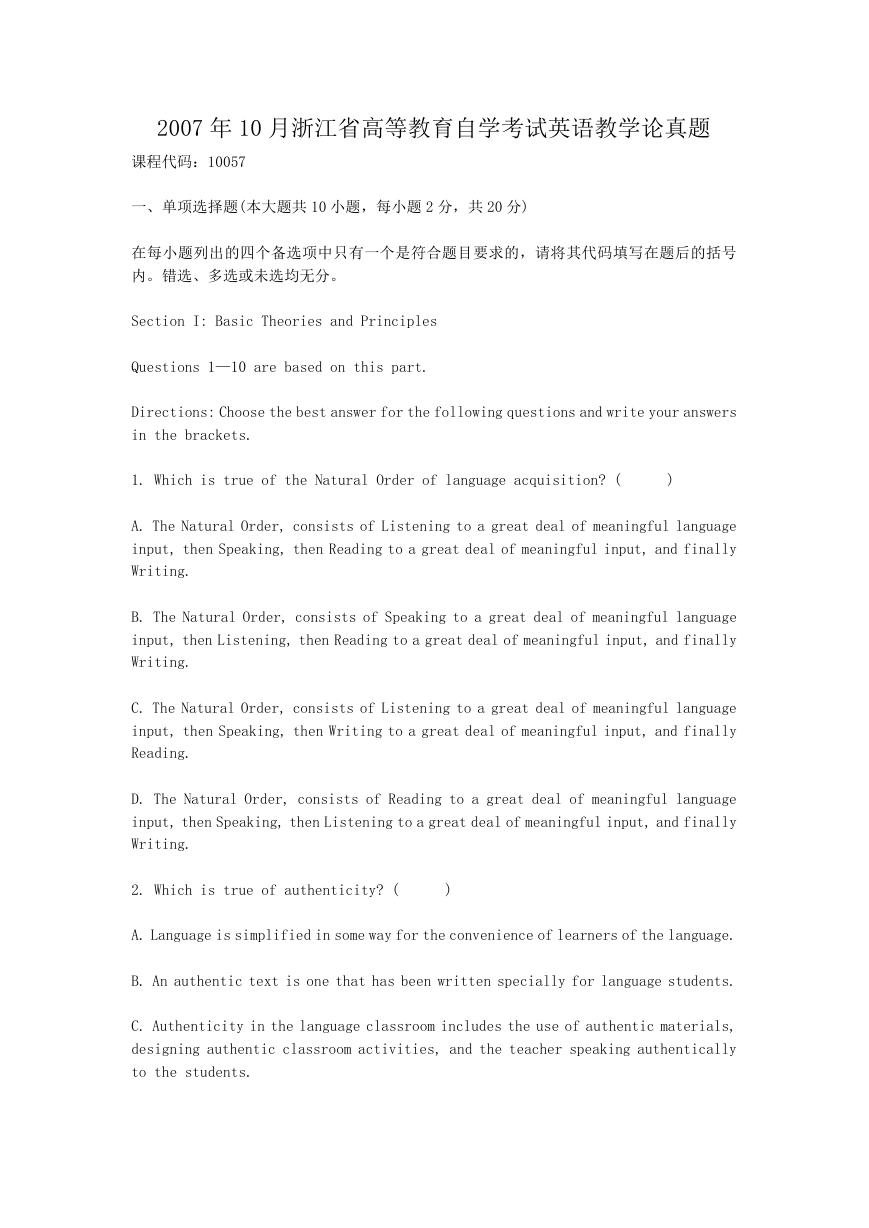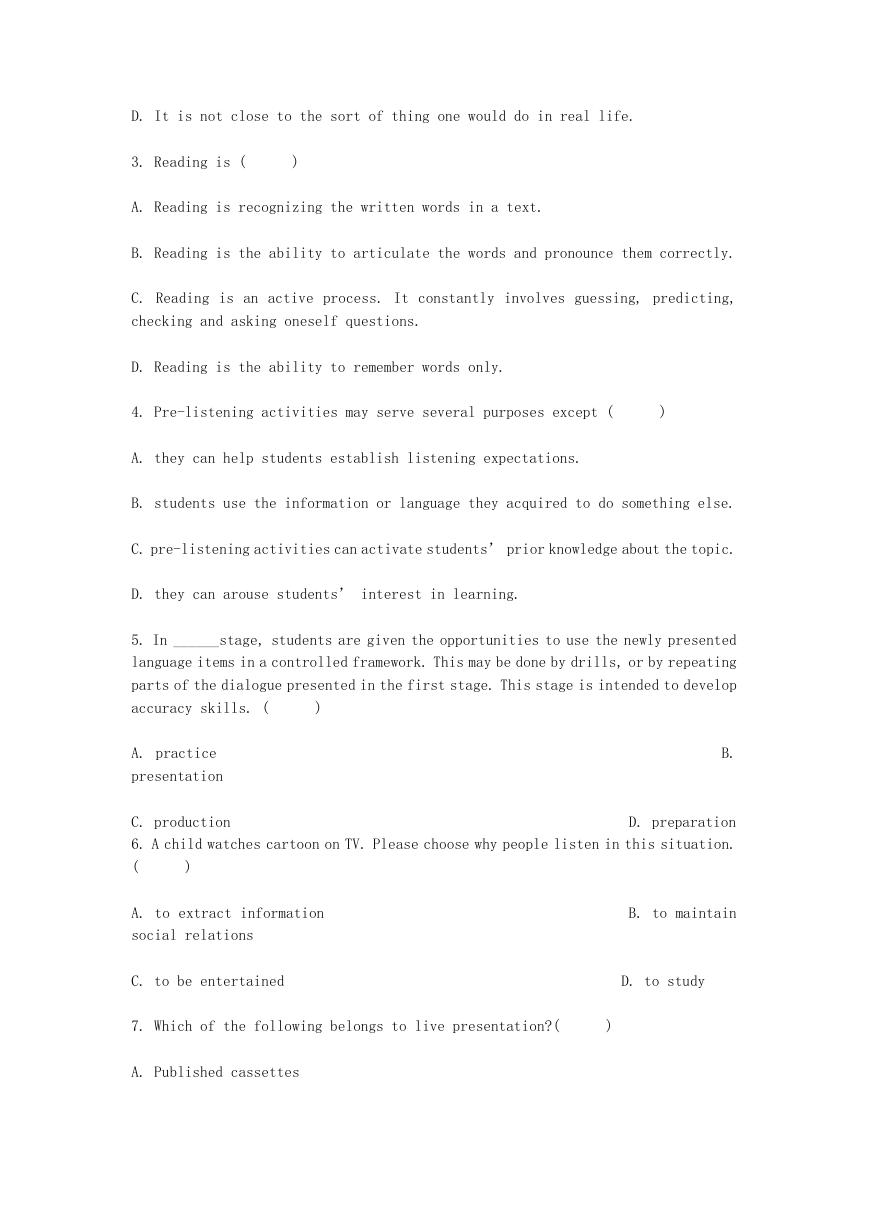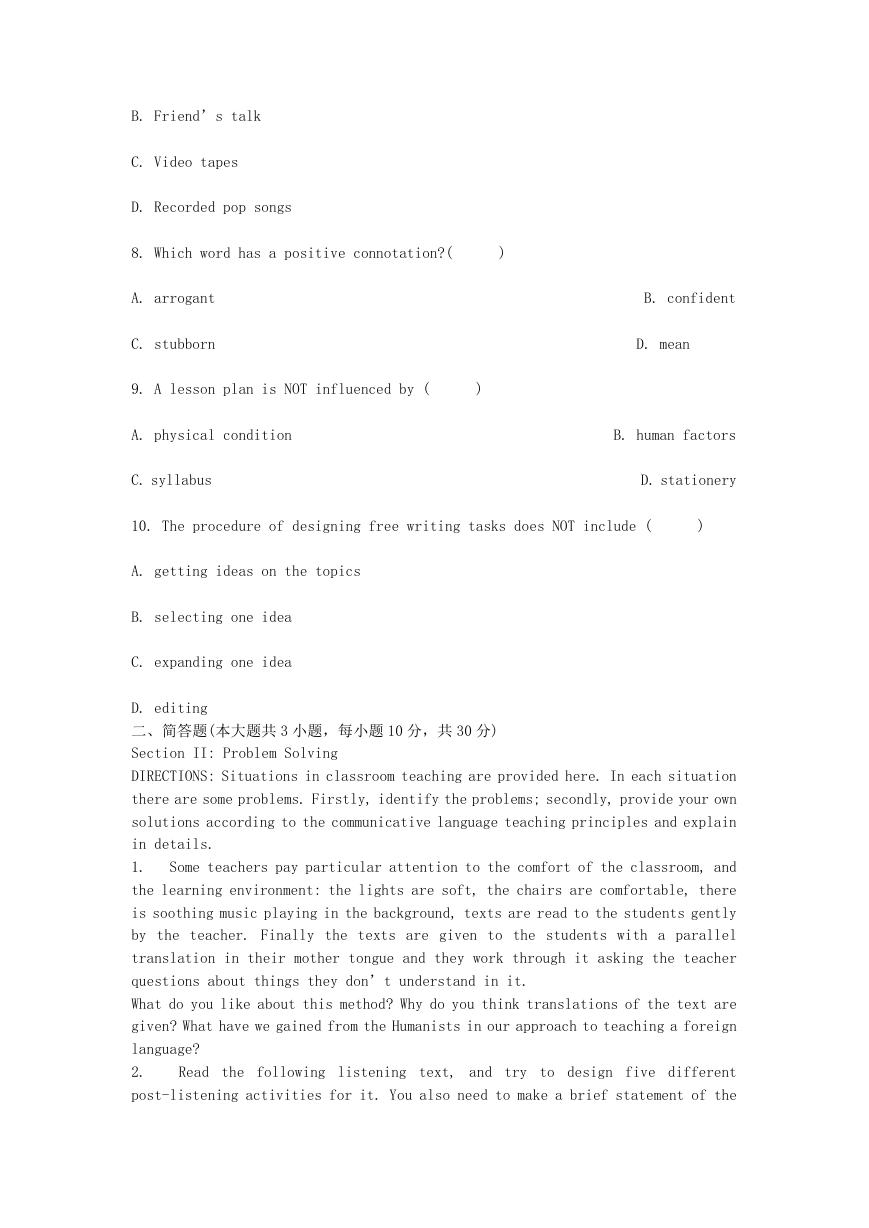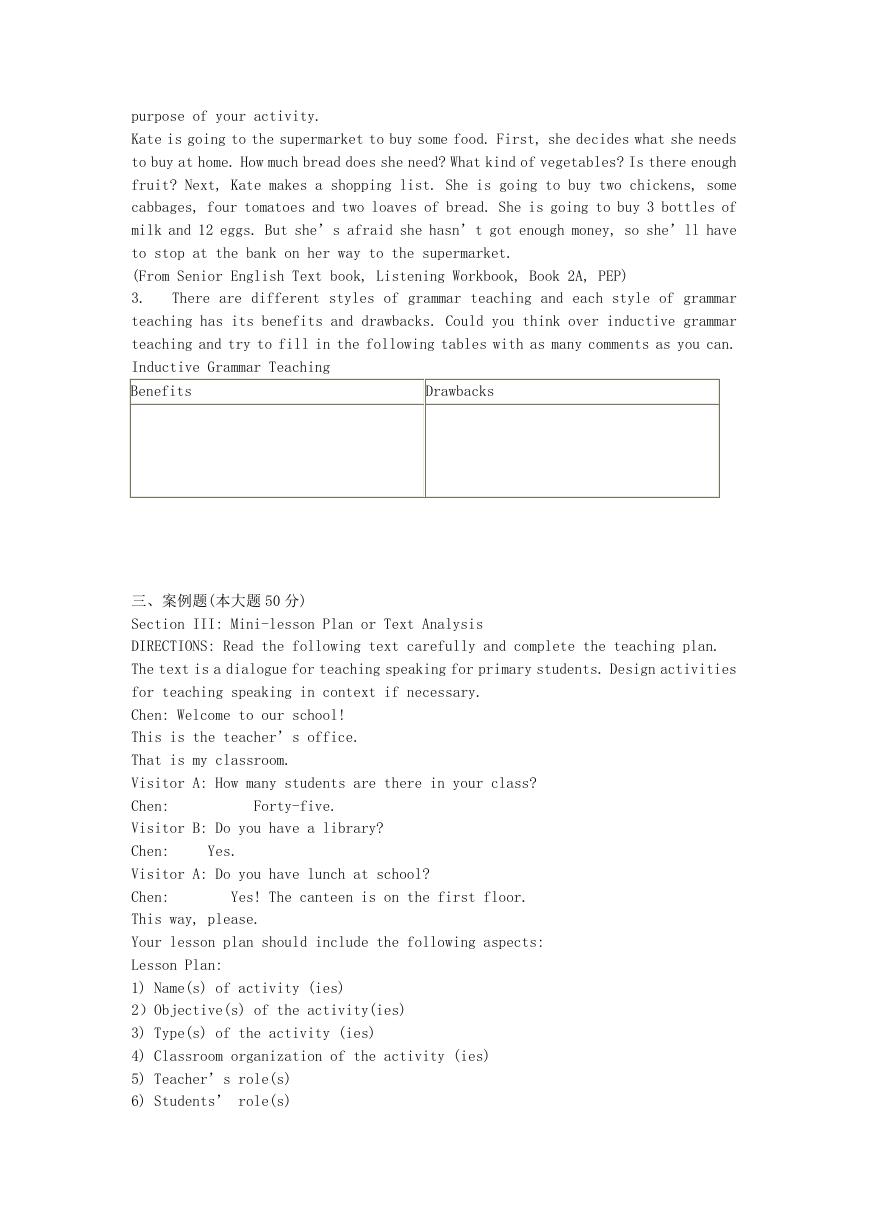2007 年 10 月浙江省高等教育自学考试英语教学论真题
课程代码:10057
一、单项选择题(本大题共 10 小题,每小题 2 分,共 20 分)
在每小题列出的四个备选项中只有一个是符合题目要求的,请将其代码填写在题后的括号
内。错选、多选或未选均无分。
Section I: Basic Theories and Principles
Questions 1—10 are based on this part.
Directions: Choose the best answer for the following questions and write your answers
in the brackets.
1. Which is true of the Natural Order of language acquisition? (
)
A. The Natural Order, consists of Listening to a great deal of meaningful language
input, then Speaking, then Reading to a great deal of meaningful input, and finally
Writing.
B. The Natural Order, consists of Speaking to a great deal of meaningful language
input, then Listening, then Reading to a great deal of meaningful input, and finally
Writing.
C. The Natural Order, consists of Listening to a great deal of meaningful language
input, then Speaking, then Writing to a great deal of meaningful input, and finally
Reading.
D. The Natural Order, consists of Reading to a great deal of meaningful language
input, then Speaking, then Listening to a great deal of meaningful input, and finally
Writing.
2. Which is true of authenticity? (
)
A. Language is simplified in some way for the convenience of learners of the language.
B. An authentic text is one that has been written specially for language students.
C. Authenticity in the language classroom includes the use of authentic materials,
designing authentic classroom activities, and the teacher speaking authentically
to the students.
�
D. It is not close to the sort of thing one would do in real life.
3. Reading is (
)
A. Reading is recognizing the written words in a text.
B. Reading is the ability to articulate the words and pronounce them correctly.
C. Reading is an active process. It constantly involves guessing, predicting,
checking and asking oneself questions.
D. Reading is the ability to remember words only.
4. Pre-listening activities may serve several purposes except (
)
A. they can help students establish listening expectations.
B. students use the information or language they acquired to do something else.
C. pre-listening activities can activate students’ prior knowledge about the topic.
D. they can arouse students’ interest in learning.
5. In ______stage, students are given the opportunities to use the newly presented
language items in a controlled framework. This may be done by drills, or by repeating
parts of the dialogue presented in the first stage. This stage is intended to develop
accuracy skills. (
)
A. practice
presentation
B.
C. production
D. preparation
6. A child watches cartoon on TV. Please choose why people listen in this situation.
(
)
A. to extract information
social relations
B. to maintain
C. to be entertained
D. to study
7. Which of the following belongs to live presentation?(
)
A. Published cassettes
�
B. Friend’s talk
C. Video tapes
D. Recorded pop songs
8. Which word has a positive connotation?(
)
A. arrogant
C. stubborn
9. A lesson plan is NOT influenced by (
)
A. physical condition
C. syllabus
B. confident
D. mean
B. human factors
D. stationery
10. The procedure of designing free writing tasks does NOT include (
)
A. getting ideas on the topics
B. selecting one idea
C. expanding one idea
D. editing
二、简答题(本大题共 3 小题,每小题 10 分,共 30 分)
Section II: Problem Solving
DIRECTIONS: Situations in classroom teaching are provided here. In each situation
there are some problems. Firstly, identify the problems; secondly, provide your own
solutions according to the communicative language teaching principles and explain
in details.
1.
Some teachers pay particular attention to the comfort of the classroom, and
the learning environment: the lights are soft, the chairs are comfortable, there
is soothing music playing in the background, texts are read to the students gently
by the teacher. Finally the texts are given to the students with a parallel
translation in their mother tongue and they work through it asking the teacher
questions about things they don’t understand in it.
What do you like about this method? Why do you think translations of the text are
given? What have we gained from the Humanists in our approach to teaching a foreign
language?
2.
Read the following listening text, and try to design five different
post-listening activities for it. You also need to make a brief statement of the
�
purpose of your activity.
Kate is going to the supermarket to buy some food. First, she decides what she needs
to buy at home. How much bread does she need? What kind of vegetables? Is there enough
fruit? Next, Kate makes a shopping list. She is going to buy two chickens, some
cabbages, four tomatoes and two loaves of bread. She is going to buy 3 bottles of
milk and 12 eggs. But she’s afraid she hasn’t got enough money, so she’ll have
to stop at the bank on her way to the supermarket.
(From Senior English Text book, Listening Workbook, Book 2A, PEP)
3.
There are different styles of grammar teaching and each style of grammar
teaching has its benefits and drawbacks. Could you think over inductive grammar
teaching and try to fill in the following tables with as many comments as you can.
Inductive Grammar Teaching
Benefits
Drawbacks
Forty-five.
Yes.
三、案例题(本大题 50 分)
Section III: Mini-lesson Plan or Text Analysis
DIRECTIONS: Read the following text carefully and complete the teaching plan.
The text is a dialogue for teaching speaking for primary students. Design activities
for teaching speaking in context if necessary.
Chen: Welcome to our school!
This is the teacher’s office.
That is my classroom.
Visitor A: How many students are there in your class?
Chen:
Visitor B: Do you have a library?
Chen:
Visitor A: Do you have lunch at school?
Chen:
This way, please.
Your lesson plan should include the following aspects:
Lesson Plan:
1) Name(s) of activity (ies)
2)Objective(s) of the activity(ies)
3) Type(s) of the activity (ies)
4) Classroom organization of the activity (ies)
5) Teacher’s role(s)
6) Students’ role(s)
Yes! The canteen is on the first floor.
�
7) Teacher working time
8) Student working time
9) Teaching aid(s)
10) Predicated problem(s)
11) Solution(s)
12) Homework
13) Procedures
A. Pre-
B. While-
C. Post-
�










 2023年江西萍乡中考道德与法治真题及答案.doc
2023年江西萍乡中考道德与法治真题及答案.doc 2012年重庆南川中考生物真题及答案.doc
2012年重庆南川中考生物真题及答案.doc 2013年江西师范大学地理学综合及文艺理论基础考研真题.doc
2013年江西师范大学地理学综合及文艺理论基础考研真题.doc 2020年四川甘孜小升初语文真题及答案I卷.doc
2020年四川甘孜小升初语文真题及答案I卷.doc 2020年注册岩土工程师专业基础考试真题及答案.doc
2020年注册岩土工程师专业基础考试真题及答案.doc 2023-2024学年福建省厦门市九年级上学期数学月考试题及答案.doc
2023-2024学年福建省厦门市九年级上学期数学月考试题及答案.doc 2021-2022学年辽宁省沈阳市大东区九年级上学期语文期末试题及答案.doc
2021-2022学年辽宁省沈阳市大东区九年级上学期语文期末试题及答案.doc 2022-2023学年北京东城区初三第一学期物理期末试卷及答案.doc
2022-2023学年北京东城区初三第一学期物理期末试卷及答案.doc 2018上半年江西教师资格初中地理学科知识与教学能力真题及答案.doc
2018上半年江西教师资格初中地理学科知识与教学能力真题及答案.doc 2012年河北国家公务员申论考试真题及答案-省级.doc
2012年河北国家公务员申论考试真题及答案-省级.doc 2020-2021学年江苏省扬州市江都区邵樊片九年级上学期数学第一次质量检测试题及答案.doc
2020-2021学年江苏省扬州市江都区邵樊片九年级上学期数学第一次质量检测试题及答案.doc 2022下半年黑龙江教师资格证中学综合素质真题及答案.doc
2022下半年黑龙江教师资格证中学综合素质真题及答案.doc